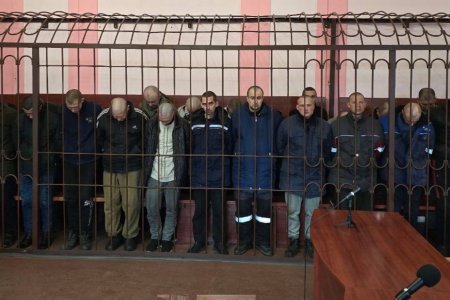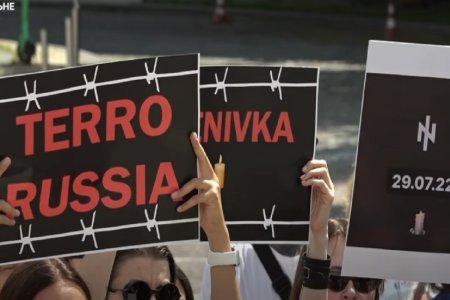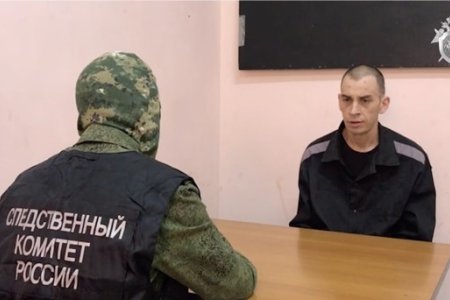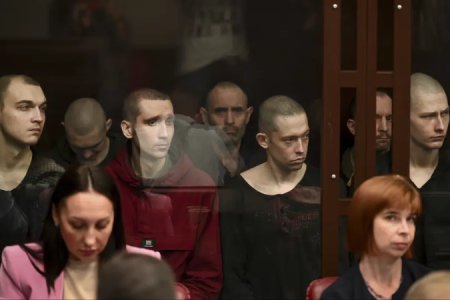
The latest report from the Independent International Commission of Inquiry on Ukraine has provided further details of Russia’s crimes against the population of Mariupol in 2022, and of Russia’s systematic torture of Ukrainian prisoners of war. None of the information can be called new, but the investigators’ findings are worth stressing given the huge number of grotesque ‘trials’ that Russia has being staging of Ukrainian POWs. All are invariably accused of precisely those attacks on the civilian population that Russia carried out, with the only ‘evidence’ of such attacks provided by the POWs themselves in ‘confessions’ almost certainly obtained through torture. These show trials and sentences of up to life imprisonment are only one of the methods that Russia has been using since May 2022 to try to rewrite the facts about its relentless bombardment and siege of Mariupol. Many of those Ukrainians forcibly taken to Russia from Mariupol were later very clearly coerced or threatened into giving absurd ‘testimony’ claiming that, for example, Russia’s missile strikes on Maternity Hospital No. 3 (on 9 March 2022) or on the Drama Theatre (16 March 2022) had somehow been carried out by Ukrainian defenders. A number of Russians are currently serving long terms of imprisonment for reporting the truth about Russian crimes in Mariupol.
The report made public on 15 March is the third from the Commission, which was created soon after Russia’s full-scale invasion of Ukraine by the UN’s Human Rights Council. The press release, expressing concern about Russia’s repeated use of explosive weapons in civilian areas, coincided with Russia’s double missile strikes on Odesa. Not only did Russia target residential buildings, but they then waited until medics and other emergency services began rescue work and struck again. The death toll currently stands at 21, with this including rescuers and medics.
The UN investigators focused on Russian forces’ “earlier indiscriminate attacks violating international humanitarian law” which caused both “civilian casualties and the destruction and damage of civilian objects, including of protected objects such as hospitals and cultural property.”
Mariupol
There is no access to independent investigators on any Ukrainian territory while under Russian occupation, however the Commission members were able to interview 50 women and 33 men who were present in Mariupol while it was under Russian attack. “Residents described periods of relentless shelling and aerial bombardments,” with this causing significant loss of life and destruction of civilian buildings.
“Two residents, for instance, witnessed tanks firing rounds at civilian residences; a woman recollected how an airstrike hit the neighbouring nine-storey building and persons living there jumped out of windows. “
By blocking access to occupied territory and demolishing the targets of Russian missile strikes, such as the Drama Theatre (which was sheltering over a thousand civilians), Russia has made it hard to assess the real number of civilians killed. The witnesses interviewed by the Commission gave harrowing accounts of seeing dead bodies strewn on the street and piled up in hospitals.
At least 58 medical infrastructure buildings were damaged or destroyed. While it was the Maternity Hospital attack on 9 March 2022 that received most publicity, there were other such direct attacks.
“Around 13 March 2022, a Main Battle Tank T72M3-variant fired at Hospital No. 2, leading to civilian casualties and damage to its fourth and fifth floors. The hospital was treating injured persons and sheltered dozens. The Commission interviewed several witnesses who suffered the impact of the attack and observed a tank with a letter “Z” mark, used by Russian armed forces, stationed in front of the building. “
Here, as it earlier concluded in the case of the 9 March 2022 attack on Maternity Hospital No. 3 and the 16 March attack on the Drama Theatre, the Commission found the attack to have been indiscriminate and in violation of international humanitarian law. The attack constituted the war crime of excessive incidental death, injury, or damage.
Witnesses have also told the Commission that they saw Russian combat vehicles and soldiers firing at civilians trying to flee the city by car.
“Survivors from Mariupol described the trauma and fear that haunt them. When asked about justice, one young woman replied: “We lived happily in wonderful Mariupol … but someone’s decision caused us to lose everything, our lives, our friends, our houses, our relatives … nothing could replace our loss … all this cannot be returned.”
In the huge number of ‘trials’ of Ukrainian prisoners of war seized in Mariupol or other parts of Donbas that Russia is currently occupying, the POWs are typically accused of killing or attempting to kill civilians. It is most often claimed that they did this by targeting just those residential buildings that the Russians were relentlessly bombing and shelling.
Russian use of torture
“New evidence strengthens the Commission’s previous findings that torture against civilians by Russian authorities in Ukraine and in the Russian Federation has been widespread and systematic.”
The new cases documented were in numerous places, with both men and women the victims, although the majority were men aged between 21 and 58. “Most victims of wilful killings and rape had also been subjected to torture.”
While in occupied Ukraine, it was typically the armed forces who carried out the torture, in Russian penal institutions, it was ‘spetsnaz’ unit, prison staff or Russia’s FSB [security service].
“Victims’ accounts disclose relentless, brutal treatment inflicting severe pain and suffering for almost the entire duration of their detention, with blatant disregard for human dignity, leading to long-lasting physical and mental trauma. One Ukrainian soldier, who was detained and tortured by Russian authorities in several detention facilities, recounted his experience in Correctional Colony No. 1 in Donskoy town. In his words, FSIN personnel beat him on the way to and from interrogation, which broke his collarbone. They forced him to do repeated jumps regardless of a surgery to his foot. He developed gangrene. They beat him on his buttocks in the isolation ward, causing bleeding from his anus. In the yard, they beat him on his face and injured foot, leading to bleeding. They knocked out some of his teeth. He begged them to kill him. Another time, they beat him until he could not feel his feet and was unable to stand. He was bleeding. “I lost any hope and will to live”, he said, and attempted suicide in his cell using his uniform. Perpetrators found him and beat him until he had a broken tailbone and toe and was bleeding. He was also tortured with electric shocks for two weeks. After release, he had undergone 36 hospitalizations as of January 2024.”
“ According to detainees, particularly harsh treatment was inflicted on prisoners of war from Mariupol city or western Ukraine; those who were not fluent in Russian; and when Russian armed forces lost control of areas in Ukraine.”
Methods of torture used recurrently included severe and repeated beatings with various instruments on different parts of the body. There were also threats of rape, objectionable touching during invasive body searches, and torture on the genitals. “Electric shocks using various tools were administered on various parts of the body, including when detainees went to the bathhouse and were wet. Another victim stated that he was in shock, as was every other fellow prisoner of war: “It was barbaric. It was unbearably painful. I was almost all the time on the floor, as my wounds were bleeding, but those animals were laughing and ordering me to stand up.”
One former detainee stated: “No creature alive deserves to be treated like Russians treat Ukrainians in their detention facilities. Over there, you don’t feel like a human being anymore.”
Both the Independent International Commission of Inquiry on Ukraine and the UN’s Rapporteur on Torture have repeatedly pointed to the systematic and widespread use of such methods. Russia is, moreover, using them against men whose imprisonment it is acknowledging, and is therefore willing to release in prisoner exchanges. It is terrifying to imagine what kind of torture those men who were subjected to show trials and have been sentenced to 25 years or life imprisonment have faced. There are also very many civilian hostages whom Russia is not even admitting to holding.
The latest press release and full report can be found here.
See also:
Russia’s killings of Ukrainian prisoners of war are likely state-approved war crimes
Huge mass ‘sentences’ after fake trial of Ukrainian POWs whom Russia accused of its own war crimes



